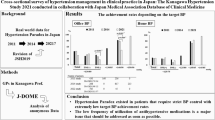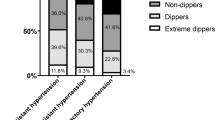Abstract
We aimed to quantify the impact of inadequate pharmacological therapy on uncontrolled blood pressure (BP) using Japanese real-world data. This retrospective cohort study used databases provided by DeSC Healthcare, Inc (Tokyo, Japan). We identified 27,652 patients with hypertension (age, 60.7 ± 9.1 years; men, 56.4%) who were not receiving antihypertensive treatment at the initial visit (pre-treatment) and were under treatment at the next visit (post-treatment). Patients were classified into the following groups by the number of antihypertensive drug classes and defined daily dose (DDD): one antihypertensive drug class with a low dose (DDD < 1.0), one antihypertensive drug class with a moderate-to-high dose (DDD ≥ 1.0), two antihypertensive drug classes with a low dose (DDD < 2.0), two antihypertensive drug classes with a moderate-to-high dose (DDD ≥ 2.0), and ≥three antihypertensive drug classes. The pre-treatment systolic/diastolic BP was 157.7 ± 15.4/94.2 ± 11.5 mmHg. Overall, 43.0% of patients had uncontrolled BP (post-treatment BP ≥ 140/ ≥ 90 mmHg). High pre-treatment BP was a strong factor for uncontrolled BP. After adjustments for covariates, including the pre-treatment mean BP, the proportion of patients with uncontrolled BP was 2.08 times higher in the one antihypertensive drug class with a low dose group than in the ≥three antihypertensive drug classes group. The preventable fraction due to <three antihypertensive drug classes for uncontrolled BP was 40.6%. Only 9.9% of patients with the pre-treatment BP ≥ 180/ ≥ 110 mmHg were prescribed ≥ three antihypertensive drug classes. High pre-treatment BP and inadequate antihypertensive treatment were major factors contributing to uncontrolled BP. Adequate treatment intensification would resolve approximately 40% of uncontrolled BP cases among Japanese patients treated for hypertension.

This is a preview of subscription content, access via your institution
Access options
Subscribe to this journal
Receive 12 print issues and online access
$259.00 per year
only $21.58 per issue
Buy this article
- Purchase on Springer Link
- Instant access to full article PDF
Prices may be subject to local taxes which are calculated during checkout



Similar content being viewed by others
References
Umemura S, Arima H, Arima S, Asayama K, Dohi Y, Hirooka Y, et al. The Japanese Society of Hypertension Guidelines for the Management of Hypertension (JSH 2019). Hypertens Res. 2019;42:1235–481.
Whelton PK, Carey RM, Aronow WS, Casey DE,Jr, Collins KJ, Dennison Himmelfarb C. et al. 2017 ACC/AHA/AAPA/ABC/ACPM/AGS/APhA/ASH/ASPC/NMA/PCNA guideline for the prevention, detection, evaluation, and management of high blood pressure in adults: a report of the American College of Cardiology/American Heart Association Task Force on clinical practice guidelines. Hypertension. 2018;71:1269–1324.
Williams B, Mancia G, Spiering W, Agabiti Rosei E, Azizi M, Burnier M. et al. 2018 ESC/ESH Guidelines for the management of arterial hypertension: the task force for the management of arterial hypertension of the European Society of Cardiology and the European Society of Hypertension. J Hypertens. 2018;36:1953–2041.
Satoh M, Asayama K, Kikuya M, Inoue R, Metoki H, Hosaka M, et al. Long-term stroke risk due to partial white-coat or masked hypertension based on home and ambulatory blood pressure measurements: the Ohasama study. Hypertension. 2016;67:48–55.
SPRINT Research Group, Lewis CE, Fine LJ, Beddhu S, Cheung AK, Cushman WC, et al. Final report of a trial of intensive versus standard blood-pressure control. N Engl J Med. 2021;384:1921–30.
Zhang W, Zhang S, Deng Y, Wu S, Ren J, Sun G, et al. Trial of intensive blood-pressure control in older patients with hypertension. N Engl J Med. 2021;385:1268–79.
Phillips LS, Branch WT, Cook CB, Doyle JP, El-Kebbi IM, Gallina DL, et al. Clinical inertia. Ann Intern Med. 2001;135:825–34.
NCD Risk Factor Collaboration. Worldwide trends in hypertension prevalence and progress in treatment and control from 1990 to 2019: a pooled analysis of 1201 population-representative studies with 104 million participants. Lancet. 2021;398:957–80.
Hisamatsu T, Segawa H, Kadota A, Ohkubo T, Arima H, Miura K. Epidemiology of hypertension in Japan: beyond the new 2019 Japanese guidelines. Hypertens Res. 2020;43:1344–51.
Ohno K, Takase H, Sugiura T, Machii M, Nonaka D, Tokumaru M, et al. Current status and recent changes in blood pressure and dietary salt consumption in Japanese individuals. Clin Exp Hypertens. 2021;43:287–94.
Fujishima S, Kodama S, Tsuchihashi T. Achievement rate of blood pressure <140/90 mmHg and <130/80 mmHg in subjects with hypertension; findings from a Japanese health checkup in 2017. Clin Exp Hypertens. 2020;42:648–55.
Yokokawa H, Suzuki M, Aoki N, Sato Y, Naito T. Achievement of target blood pressure among community residents with hypertension and factors associated with therapeutic failure in the northern territory of Japan. J Int Med Res. 2022;50:3000605221126878.
Ali DH, Kilic B, Hart HE, Bots ML, Biermans MCJ, Spiering W, et al. Therapeutic inertia in the management of hypertension in primary care. J Hypertens. 2021;39:1238–45.
Khosravi A, Nazemipour M, Shinozaki T, Mansournia MA. Population attributable fraction in textbooks: time to revise. Global Epidemiol. 2021;3:100062.
Satoh M, Murakami T, Obara T, Metoki H. Time-series analysis of blood pressure changes after the guideline update in 2019 and the coronavirus disease pandemic in 2020 using Japanese longitudinal data. Hypertens Res. 2022;45:1408–17.
Eba J, Nakamura K. Overview of the ethical guidelines for medical and biological research involving human subjects in Japan. Jpn J Clin Oncol. 2022;52:539–44.
Satoh M, Hirose T, Satoh H, Nakayama S, Obara T, Murakami T, et al. Actual impact of angiotensin II receptor blocker or calcium channel blocker monotherapy on renal function in real-world patients. J Hypertens. 2022;40:1564–76.
World Health Organization. World Health organization collaborating centre for drug statistics methodology system of defined daily doses. https://www.whocc.no/atc_ddd_index/. Accessed 15 Dec 2022.
Chowdhury R, Khan H, Heydon E, Shroufi A, Fahimi S, Moore C, et al. Adherence to cardiovascular therapy: a meta-analysis of prevalence and clinical consequences. Eur Heart J. 2013;34:2940–8.
Austin PC. Balance diagnostics for comparing the distribution of baseline covariates between treatment groups in propensity-score matched samples. Stat Med. 2009;28:3083–107.
Barros AJ, Hirakata VN. Alternatives for logistic regression in cross-sectional studies: an empirical comparison of models that directly estimate the prevalence ratio. BMC Med Res Methodol. 2003;3:21.
Watabe D, Asayama K, Hanazawa T, Hosaka M, Satoh M, Yasui D, et al. Predictive power of home blood pressure indices at baseline and during follow-up in hypertensive patients: HOMED-BP study. Hypertens Res. 2018;41:622–8.
Asayama K, Ohkubo T, Metoki H, Obara T, Inoue R, Kikuya M, et al. Cardiovascular outcomes in the first trial of antihypertensive therapy guided by self-measured home blood pressure. Hypertens Res. 2012;35:1102–10.
Pickersgill SJ, Msemburi WT, Cobb L, Ide N, Moran AE, Su Y, et al. Modeling global 80-80-80 blood pressure targets and cardiovascular outcomes. Nat Med. 2022;28:1693–9.
Wald DS, Law M, Morris JK, Bestwick JP, Wald NJ. Combination therapy versus monotherapy in reducing blood pressure: meta-analysis on 11,000 participants from 42 trials. Am J Med. 2009;122:290–300.
Hosaka M, Metoki H, Satoh M, Ohkubo T, Asayama K, Kikuya M, et al. Randomized trial comparing the velocities of the antihypertensive effects on home blood pressure of candesartan and candesartan with hydrochlorothiazide. Hypertens Res. 2015;38:701–7.
Metoki H, Ohkubo T, Kikuya M, Asayama K, Inoue R, Obara T, et al. The velocity of antihypertensive effect of losartan/hydrochlorothiazide and angiotensin II receptor blocker. J Hypertens. 2012;30:1478–86.
Ohishi M, Yoshida T, Oh A, Hiroi S, Takeshima T, Otsuka Y, et al. Analysis of antihypertensive treatment using real-world Japanese data-the retrospective study of antihypertensives for lowering blood pressure (REAL) study. Hypertens Res. 2019;42:1057–67.
Obara T, Ito K, Ohkubo T, Shibamiya T, Shinki T, Nakashita M, et al. Uncontrolled hypertension based on morning and evening home blood pressure measurements from the J-HOME study. Hypertens Res. 2009;32:1072–8.
Jiao T, Platt RW, Douros A, Filion KB. Prescription patterns for the use of antihypertensive drugs for primary prevention among patients with hypertension in the United Kingdom. Am J Hypertens. 2022;35:42–53.
Tajeu GS, Kent ST, Kronish IM, Huang L, Krousel-Wood M, Bress AP, et al. Trends in antihypertensive medication discontinuation and low adherence among medicare beneficiaries initiating treatment from 2007 to 2012. Hypertension. 2016;68:565–75.
Elnagar N, Satoh M, Hosaka M, Asayama K, Ishikura K, Obara T, et al. The velocity of home blood pressure reduction in response to low-dose eplerenone combined with other antihypertensive drugs determined by exponential decay function analysis. Clin Exp Hypertens. 2014;36:83–91.
Oikawa T, Obara T, Ohkubo T, Kikuya M, Asayama K, Metoki H, et al. Characteristics of resistant hypertension determined by self-measured blood pressure at home and office blood pressure measurements: the J-HOME study. J Hypertens. 2006;24:1737–43.
Waki T, Miura K, Tanaka-Mizuno S, Ohya Y, Node K, Itoh H, et al. Prevalence of hypertensive diseases and treated hypertensive patients in Japan: a nationwide administrative claims database study. Hypertens Res. 2022;45:1123–33.
Nishimura S, Kumamaru H, Shoji S, Sawano M, Kohsaka S, Miyata H. Adherence to antihypertensive medication and its predictors among non-elderly adults in Japan. Hypertens Res. 2020;43:705–14.
Ishida T, Oh A, Hiroi S, Shimasaki Y, Nishigaki N, Tsuchihashi T. Treatment patterns and adherence to antihypertensive combination therapies in Japan using a claims database. Hypertens Res. 2019;42:249–56.
Morgado M, Rolo S. Factors influencing medication adherence and hypertension management revisited: recent insights from cancer survivors. Hypertens Res. 2012;35:894–6.
Williams B, Shaw A, Durrant R, Crinson I, Pagliari C, de Lusignan S. Patient perspectives on multiple medications versus combined pills: a qualitative study. QJM. 2005;98:885–93.
Merlo J, Wessling A, Melander A. Comparison of dose standard units for drug utilisation studies. Eur J Clin Pharmacol. 1996;50:27–30.
Sano H, Hara A, Asayama K, Miyazaki S, Kikuya M, Imai Y, et al. Antihypertensive drug effects according to the pretreatment self-measured home blood pressure: the HOMED-BP study. BMJ Open. 2020;10:e040524.
Acknowledgements
We thank Ms. Saki Sato and the staff at DeSC Healthcare, Inc. The present study used the database provided by DeSC Healthcare, Inc., under their academic research support program. The summary of this study was presented at the 59th Annual Meeting of the Japanese Society of Cardiovascular Disease Prevention, and Satoh M received first place in the Young Investigator’s Award.
Funding
This study was supported by Grants for Scientific Research (17K15853 and 21K10478) from the Ministry of Education, Culture, Sports, Science and Technology, Japan; the academic support from Bayer Yakuhin Co, Ltd; Health Care Science Institute Research Grant; and Foundation for Total Health Promotion. This study was awarded the Medical Research Encouragement Prize of the Japan Medical Association.
Author information
Authors and Affiliations
Corresponding author
Ethics declarations
Conflict of interest
MS received Academic support from Bayer Yakuhin Co, Ltd. KA, TO, YI and HM concurrently held the position of Director of the Tohoku Institute for Management of Blood Pressure, which was supported by Omron Healthcare Co, Ltd.
Additional information
Publisher’s note Springer Nature remains neutral with regard to jurisdictional claims in published maps and institutional affiliations.
Supplementary information
Rights and permissions
Springer Nature or its licensor (e.g. a society or other partner) holds exclusive rights to this article under a publishing agreement with the author(s) or other rightsholder(s); author self-archiving of the accepted manuscript version of this article is solely governed by the terms of such publishing agreement and applicable law.
About this article
Cite this article
Satoh, M., Muroya, T., Murakami, T. et al. The impact of clinical inertia on uncontrolled blood pressure in treated hypertension: real-world, longitudinal data from Japan. Hypertens Res 47, 598–607 (2024). https://doi.org/10.1038/s41440-023-01452-2
Received:
Revised:
Accepted:
Published:
Issue Date:
DOI: https://doi.org/10.1038/s41440-023-01452-2
Keywords
This article is cited by
-
Preface-various factors in the management of blood pressure
Hypertension Research (2024)



